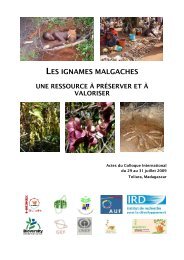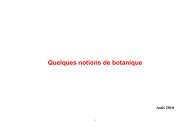brochure en pdf - formad-environnement
brochure en pdf - formad-environnement
brochure en pdf - formad-environnement
You also want an ePaper? Increase the reach of your titles
YUMPU automatically turns print PDFs into web optimized ePapers that Google loves.
Quelques référ<strong>en</strong>ces sur Moringa sp.<br />
Abuye C., Urga K., Knapp H., Selmar K., Omwega A.M., Imungi J.K., Winterhalter P. 2003.<br />
A compositional study of Moringa st<strong>en</strong>opetala leaves. East African Medical Journal 80(5): 247–<br />
250.<br />
B<strong>en</strong>nett R.N., Mellon F.A., Foidl N., Pratt J.H., Dupont M.S., Perkins L., Kroon P.A. 2003.<br />
Profiling glucosinolates and ph<strong>en</strong>olics in vegetative and reproductive tissues of the multi-purpose<br />
trees Moringa oleifera L. (Horseradish tree) and Moringa st<strong>en</strong>opetala L. Journal of Agricultural and<br />
Food Chemistry 51(12): 3546–3553.<br />
Bosch C.H. 2004. Moringa oleifera Lam. In: Grubb<strong>en</strong>, G.J.H. & D<strong>en</strong>ton, O.A. (Éds). PROTA 2:<br />
Vegetables/Légumes. [CD-Rom]. PROTA, Wag<strong>en</strong>ing<strong>en</strong>, Pays Bas.<br />
Bosch C.H. 2004. Moringa st<strong>en</strong>opetala (Baker f.) Cufod. [Internet] Fiche de Protabase. Grubb<strong>en</strong>,<br />
G.J.H. & D<strong>en</strong>ton, O.A. (Éds). PROTA (Plant Resources of Tropical Africa / Ressources végétales<br />
de l’Afrique tropicale), Wag<strong>en</strong>ing<strong>en</strong>, Pays Bas. http://database.prota.org/recherche.htm.<br />
Bukar A., Uba A. and Oyeyi T.I. 2010. Antimicrobial profil of Moringa oleifera Lam. extracts<br />
against some food-borne microorganisms. Bayero Journal of Pure and Applied Sci<strong>en</strong>ces, 3(1): 43-<br />
48.<br />
Abstract: The chloroform and ethanol extracts of seeds and leaf of Moringa oleifera were investigated for<br />
antimicrobial activity against some selected food – borne microorganisms as a first step in the scre<strong>en</strong>ing of the extracts<br />
for preliminary sanitizing/preservative properties on foods. Thepreliminary phytochemical scre<strong>en</strong>ing and antimicrobial<br />
assay were carried out using standard procedures. The results of the phytochemical analysis revealed differ<strong>en</strong>ces in the<br />
pres<strong>en</strong>ce of the phytochemicals among the extracts. Saponins were detected in all the extracts while tannins were only<br />
detected in Moringa oleifera leaf chloroform extract. The antibacterial assay results show that M. oleifera leaf ethanol<br />
extract exhibited broad spectrum activity against the test organisms with Escherichia coli, Pseudomonas aeruginosa,<br />
Staphylococcus aureus and Enterobacter aerog<strong>en</strong>es susceptible. The MIC values ranged betwe<strong>en</strong> 2.0 and >4.0mg/ml for<br />
all the organisms. M. oleifera seed chloroform extract was only active against E. coli and Salmonella typhimurium. The<br />
MIC values ranged betwe<strong>en</strong> 1.0 and >4.0mg/ml for the tested organisms respectively. Antifungal activity result revealed<br />
100% inhibition in growth of Mucor and Rhizopus species by M. oleifera seed chloroform extract at conc<strong>en</strong>tration of<br />
1mg/ml. Standard Ketoconazole (control) inhibited the test organisms by 100% at 0.5mg/ml concertration. The result of<br />
this study have shown the pot<strong>en</strong>tials of M. oleifera extracts as sanitizers/preservatives by inhibiting the growth of the<br />
test organisms, which range from food – borne pathog<strong>en</strong>s to spoilage causing organisms in foods.<br />
Burkill H.M. 1997. The useful plants of West Tropical Africa. 2nd Ed. Vol 4, Families M–R. Royal<br />
Botanic Gard<strong>en</strong>s, Kew, United Kingdom. 969 p.<br />
CSIR. 1962. The wealth of India. A dictionary of Indian raw materials and industrial products. Raw<br />
materials. Volume 6: L–M. Council of Sci<strong>en</strong>tific and Industrial Research, New Delhi, India. 483 pp.<br />
de Saint-Sauveur A. 1993. Le moringa, un arbre a multiples usages pour le Sahel. In: Riedacker,<br />
A., Dreyer, E., Pafadnam, C., Joly, H. & Bory, G. (Eds). Physiologie des arbres et arbustes <strong>en</strong> zones<br />
arides et semi-arides : séminaire Paris-Nancy, 20 mars–6 avril 1990. Libbey, Paris, France. Pp. 441–<br />
446.<br />
de Saint Sauveur A. 2001. Moringa exploitation in the world: state of knowledge and chall<strong>en</strong>ges.<br />
Paper pres<strong>en</strong>ted at the confer<strong>en</strong>ce Developm<strong>en</strong>t pot<strong>en</strong>tial of Moringa products, held 29 October–2<br />
November 2001 in Dar es Salaam, Tanzania. http://www.moringanews.org/ actes/<br />
saintsauveur_<strong>en</strong>.doc. Accessed October 2006.<br />
Delaveau P., Boiteau P. 1980. Huiles a intérêt pharmacologique, cosmétologique et diététique: IV -<br />
Huiles de Moringa oleifera Lam. et de Moringa drouhardii Jumelle. Plantes médicinales et<br />
Phytothérapie 14: 29–33.<br />
Demeul<strong>en</strong>aere E. 2001. Moringa st<strong>en</strong>opetala, a subsist<strong>en</strong>ce resource in the Konso district.<br />
Developm<strong>en</strong>t pot<strong>en</strong>tial of Moringa products. Proceedings of a workshop held 29 Oct.–2 Nov. 2001<br />
29





